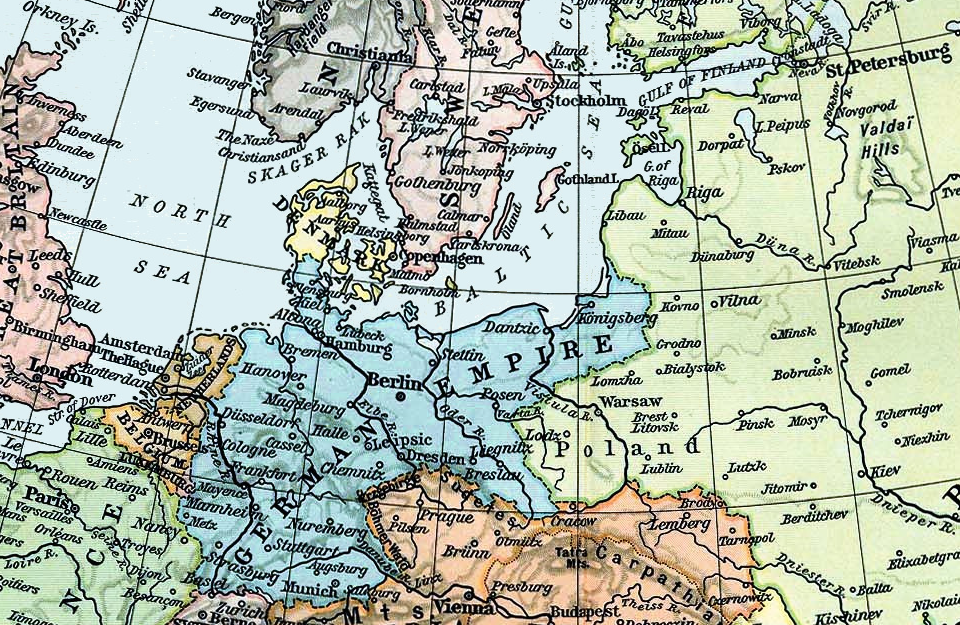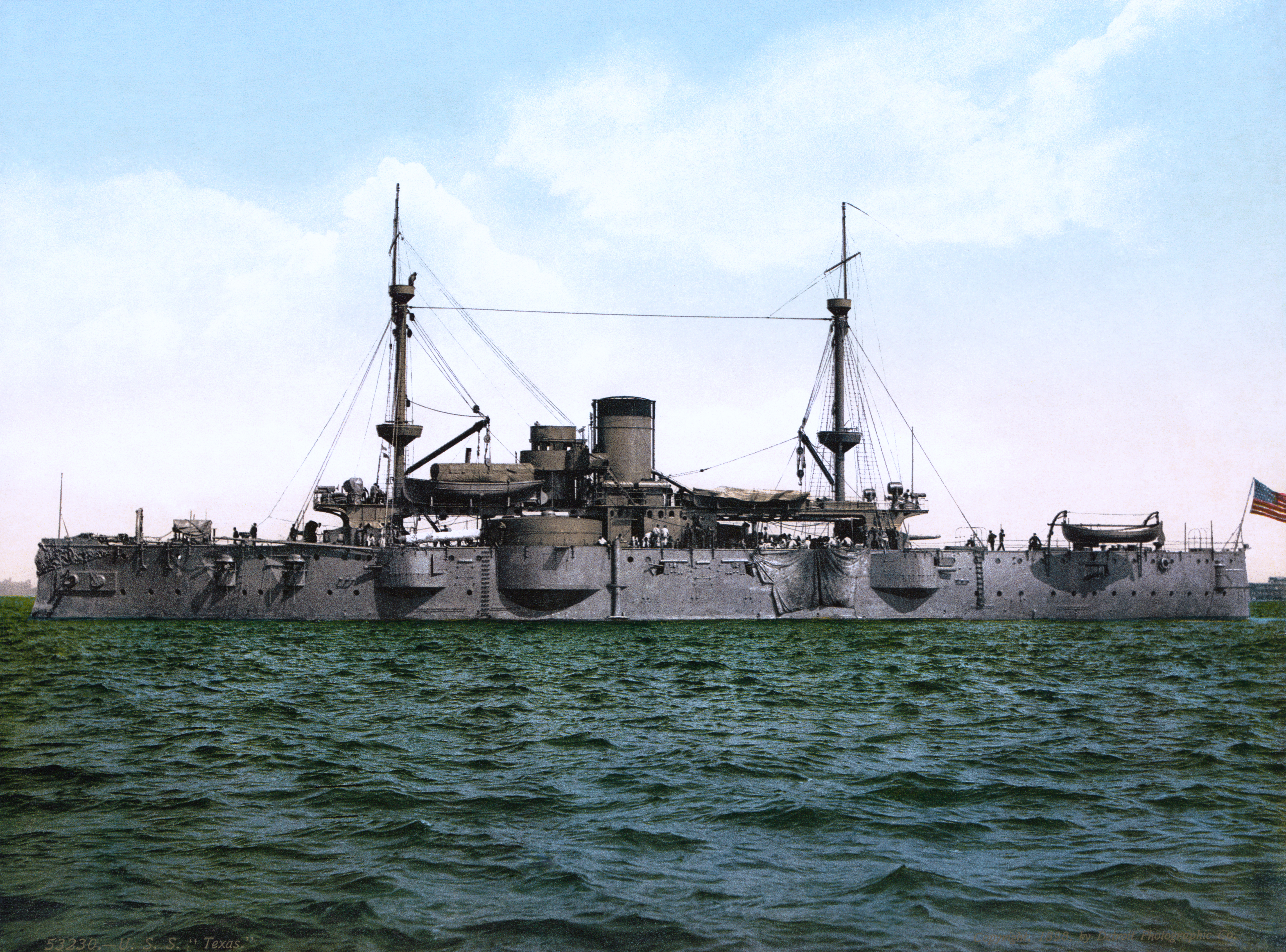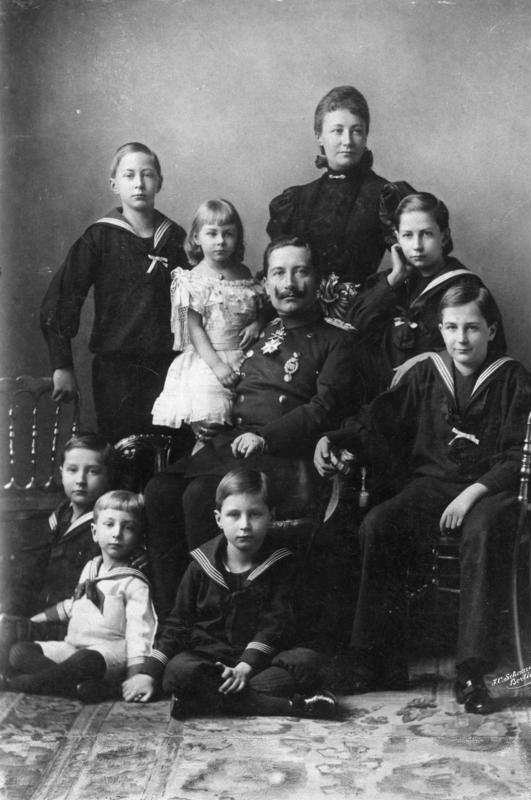|
SMS Mecklenburg
SMS ("His Majesty's Ship ")). was the fifth ship of the of pre-dreadnought battleships of the German Imperial Navy. Laid down in May 1900 at the AG Vulcan shipyard in Stettin, Germany (now Szczecin, Poland), she was finished in May 1903. Her sister ships were , , , and ; they were the first capital ships built under the Navy Law of 1898, championed by Admiral Alfred von Tirpitz. was armed with a main battery of four guns and had a top speed of . spent the early period of her career in I Squadron of the German fleet, participating in the peacetime routine of training cruises and exercises. After World War I began in August 1914, the ship was mobilized with her sisters as IV Battle Squadron. She saw limited duty in the Baltic Sea against Russian naval forces, and as a guard ship in the North Sea. The German High Command withdrew the ship from active service in January 1916 due to a threat from submarines and naval mines, together with severe shortages in personnel. For ... [...More Info...] [...Related Items...] OR: [Wikipedia] [Google] [Baidu] |
German Empire
The German Empire (), Herbert Tuttle wrote in September 1881 that the term "Reich" does not literally connote an empire as has been commonly assumed by English-speaking people. The term literally denotes an empire – particularly a hereditary empire led by an emperor, although has been used in German to denote the Roman Empire because it had a weak hereditary tradition. In the case of the German Empire, the official name was , which is properly translated as "German Empire" because the official position of head of state in the constitution of the German Empire was officially a " presidency" of a confederation of German states led by the King of Prussia who would assume "the title of German Emperor" as referring to the German people, but was not emperor of Germany as in an emperor of a state. –The German Empire" ''Harper's New Monthly Magazine''. vol. 63, issue 376, pp. 591–603; here p. 593. also referred to as Imperial Germany, the Second Reich, as well as simply Germa ... [...More Info...] [...Related Items...] OR: [Wikipedia] [Google] [Baidu] |
Pre-dreadnought
Pre-dreadnought battleships were sea-going battleships built between the mid- to late- 1880s and 1905, before the launch of in 1906. The pre-dreadnought ships replaced the ironclad battleships of the 1870s and 1880s. Built from steel, protected by case-hardened steel armour, and powered by coal-fired triple-expansion steam engines, pre-dreadnought battleships carried a main battery of very heavy guns in fully enclosed rotating turrets supported by one or more secondary batteries of lighter weapons. In contrast to the multifarious development of ironclad warships in preceding decades, the 1890s saw navies worldwide start to build battleships to a common design as dozens of ships essentially followed the design of the Royal Navy's . The similarity in appearance of battleships in the 1890s was underlined by the increasing number of ships being built. New naval powers such as Germany, Japan, the United States, and to a lesser extent Italy and Austria-Hungary, began to estab ... [...More Info...] [...Related Items...] OR: [Wikipedia] [Google] [Baidu] |
Guard Ship
A guard ship is a warship assigned as a stationary guard in a port or harbour, as opposed to a coastal patrol boat, which serves its protective role at sea. Royal Navy In the Royal Navy of the eighteenth century, peacetime guard ships were usually third-rate or fourth-rate ships of the line. The larger ships in the fleet would be laid up "in ordinary" with skeleton crews, the spars, sails and rigging removed and the decks covered by canvas – the historic equivalent of a reserve fleet. By contrast the guard ships would carry sails and rigging aboard, be defouled below the waterline to increase their speed under sail, and be manned by at least one quarter of their normal crew. A port or major waterway may be assigned a single guardship which would also serve as the naval headquarters for the area. Multiple guardships were required at larger ports and Royal Dockyards, with the largest single vessel routinely serving as the Port Admiral's flagship. If war was declared, or an e ... [...More Info...] [...Related Items...] OR: [Wikipedia] [Google] [Baidu] |
Baltic Sea
The Baltic Sea is an arm of the Atlantic Ocean that is enclosed by Denmark, Estonia, Finland, Germany, Latvia, Lithuania, Poland, Russia, Sweden and the North and Central European Plain. The sea stretches from 53°N to 66°N latitude and from 10°E to 30°E longitude. A marginal sea of the Atlantic, with limited water exchange between the two water bodies, the Baltic Sea drains through the Danish Straits into the Kattegat by way of the Øresund, Great Belt and Little Belt. It includes the Gulf of Bothnia, the Bay of Bothnia, the Gulf of Finland, the Gulf of Riga and the Bay of Gdańsk. The "Baltic Proper" is bordered on its northern edge, at latitude 60°N, by Åland and the Gulf of Bothnia, on its northeastern edge by the Gulf of Finland, on its eastern edge by the Gulf of Riga, and in the west by the Swedish part of the southern Scandinavian Peninsula. The Baltic Sea is connected by artificial waterways to the White Sea via the White Sea–Baltic Canal and to ... [...More Info...] [...Related Items...] OR: [Wikipedia] [Google] [Baidu] |
IV Battle Squadron
IV may refer to: Businesses and organizations *Immigration Voice, an activist organization *Industrievereinigung, Federation of Austrian Industry * Intellectual Ventures, a privately held intellectual property company *InterVarsity Christian Fellowship * Irish Volunteers, a military organization *Italia Viva, an Italian centrist political party, led by former prime minister Matteo Renzi Music *Subdominant, in music theory Recordings * ''IV'' (The 1975 EP), 2013 * ''IV'' (The Aggrolites album), 2009 * ''IV'' (Angband album), 2020 * ''IV'' (BadBadNotGood album), 2016 * ''IV'' (Black Mountain album), 2016 * ''IV'' (Cypress Hill album), 1998 * ''IV'' (Diamond Rio album), 1996 * ''IV'' (Goatsnake album), 1998 * ''IV'' (Godsmack album), 2006 * ''IV'' (Hiroyuki Sawano album), 2021 * ''I.V.'' (Loma Prieta album), 2012 * ''IV'' (The Lookouts album), 1990 * ''IV'' (Maylene and the Sons of Disaster album), 2011 * ''IV'' (Ton Steine Scherben album), 1981 * ''IV'' (The Stranglers album), 1980 ... [...More Info...] [...Related Items...] OR: [Wikipedia] [Google] [Baidu] |
World War I
World War I (28 July 1914 11 November 1918), often abbreviated as WWI, was List of wars and anthropogenic disasters by death toll, one of the deadliest global conflicts in history. Belligerents included much of Europe, the Russian Empire, the United States, and the Ottoman Empire, with fighting occurring throughout Europe, the Middle East, Africa, the Pacific Ocean, Pacific, and parts of Asia. An estimated 9 million soldiers were killed in combat, plus another 23 million wounded, while 5 million civilians died as a result of military action, hunger, and disease. Millions more died in Genocides in history (World War I through World War II), genocides within the Ottoman Empire and in the Spanish flu, 1918 influenza pandemic, which was exacerbated by the movement of combatants during the war. Prior to 1914, the European great powers were divided between the Triple Entente (comprising French Third Republic, France, Russia, and British Empire, Britain) and the Triple A ... [...More Info...] [...Related Items...] OR: [Wikipedia] [Google] [Baidu] |
I Battle Squadron
The I Battle Squadron was a unit of the German Imperial Navy before and during World War I. Being part of the High Seas Fleet, the squadron saw action throughout the war, including the Battle of Jutland on 31 May – 1 June 1916, where it formed the center of the German line Line most often refers to: * Line (geometry), object with zero thickness and curvature that stretches to infinity * Telephone line, a single-user circuit on a telephone communication system Line, lines, The Line, or LINE may also refer to: Art .... Notes References * * * * See also * Imperial German Navy order of battle (1914) Naval units and formations of Germany in World War I Military units and formations of the Imperial German Navy {{Germany-mil-unit-stub ... [...More Info...] [...Related Items...] OR: [Wikipedia] [Google] [Baidu] |
Alfred Von Tirpitz
Alfred Peter Friedrich von Tirpitz (19 March 1849 – 6 March 1930) was a German grand admiral, Secretary of State of the German Imperial Naval Office, the powerful administrative branch of the German Imperial Navy from 1897 until 1916. Prussia never had a major navy, nor did the other German states before the German Empire was formed in 1871. Tirpitz took the modest Imperial Navy and, starting in the 1890s, turned it into a world-class force that could threaten Britain's Royal Navy. However, during World War I, his High Seas Fleet proved unable to end Britain's command of the sea and its chokehold on Germany's economy. The one great engagement at sea, the Battle of Jutland, ended in a narrow German tactical victory but a strategic failure. As the High Seas Fleet's limitations became increasingly apparent during the war, Tirpitz became an outspoken advocate for unrestricted submarine warfare, a policy which would ultimately bring Germany into conflict with the United States. By ... [...More Info...] [...Related Items...] OR: [Wikipedia] [Google] [Baidu] |
Admiral
Admiral is one of the highest ranks in some navies. In the Commonwealth nations and the United States, a "full" admiral is equivalent to a "full" general in the army or the air force, and is above vice admiral and below admiral of the fleet, or fleet admiral. Etymology The word in Middle English comes from Anglo-French , "commander", from Medieval Latin , . These evolved from the Arabic () – (), “king, prince, chief, leader, nobleman, lord, a governor, commander, or person who rules over a number of people,” and (), the Arabic article answering to “the.” In Arabic, admiral is also represented as (), where () means the sea. The 1818 edition of Samuel Johnson's ''A Dictionary of the English Language'', edited and revised by the Rev. Henry John Todd, states that the term “has been traced to the Arab. emir or amir, lord or commander, and the Gr. , the sea, q. d. ''prince of the sea''. The word is written both with and without the d, in other languages, ... [...More Info...] [...Related Items...] OR: [Wikipedia] [Google] [Baidu] |
German Naval Laws
The Naval Laws (german: Flottengesetze, "Fleet Laws") were five separate laws passed by the German Empire, in 1898, 1900, 1906, 1908, and 1912. These acts, championed by Kaiser Wilhelm II and his Secretary of State for the Navy, Grand Admiral Alfred von Tirpitz, committed Germany to building up a navy capable of competing with the Royal Navy of the United Kingdom. German desires and the strategic debate The Kaiser had long wanted a large naval force to assure Germany of what he called " a place in the sun". A large German navy could assist in German attempts to attain colonies, as well as further the country's economic and commercial interests elsewhere in the world. He was determined to make his country a colonial power in Africa and the Pacific. He was also a very militaristic man, and wished to increase the strength of the German armed forces; in particular he wanted to develop a navy that could match the British Royal Navy. As he wrote in his autobiography: Though Wilh ... [...More Info...] [...Related Items...] OR: [Wikipedia] [Google] [Baidu] |
Sister Ship
A sister ship is a ship of the same class or of virtually identical design to another ship. Such vessels share a nearly identical hull and superstructure layout, similar size, and roughly comparable features and equipment. They often share a common naming theme, either being named after the same type of thing or person (places, constellations, heads of state) or with some kind of alliteration. Typically the ship class is named for the first ship of that class. Often, sisters become more differentiated during their service as their equipment (in the case of naval vessels, their armament) are separately altered. For instance, the U.S. warships , , , and are all sister ships, each being an . Perhaps the most famous sister ships were the White Star Line's s, consisting of , and . As with some other liners, the sisters worked as running mates. Other sister ships include the Royal Caribbean International's and . ''Half-sister'' refers to a ship of the same class but with som ... [...More Info...] [...Related Items...] OR: [Wikipedia] [Google] [Baidu] |
Szczecin
Szczecin (, , german: Stettin ; sv, Stettin ; Latin: ''Sedinum'' or ''Stetinum'') is the capital and largest city of the West Pomeranian Voivodeship in northwestern Poland. Located near the Baltic Sea and the German border, it is a major seaport and Poland's seventh-largest city. As of December 2021, the population was 395,513. Szczecin is located on the river Oder, south of the Szczecin Lagoon and the Bay of Pomerania. The city is situated along the southwestern shore of Dąbie Lake, on both sides of the Oder and on several large islands between the western and eastern branches of the river. Szczecin is adjacent to the town of Police and is the urban centre of the Szczecin agglomeration, an extended metropolitan area that includes communities in the German states of Brandenburg and Mecklenburg-Western Pomerania. Szczecin is the administrative and industrial centre of West Pomeranian Voivodeship and is the site of the University of Szczecin, Pomeranian Medical Uni ... [...More Info...] [...Related Items...] OR: [Wikipedia] [Google] [Baidu] |







